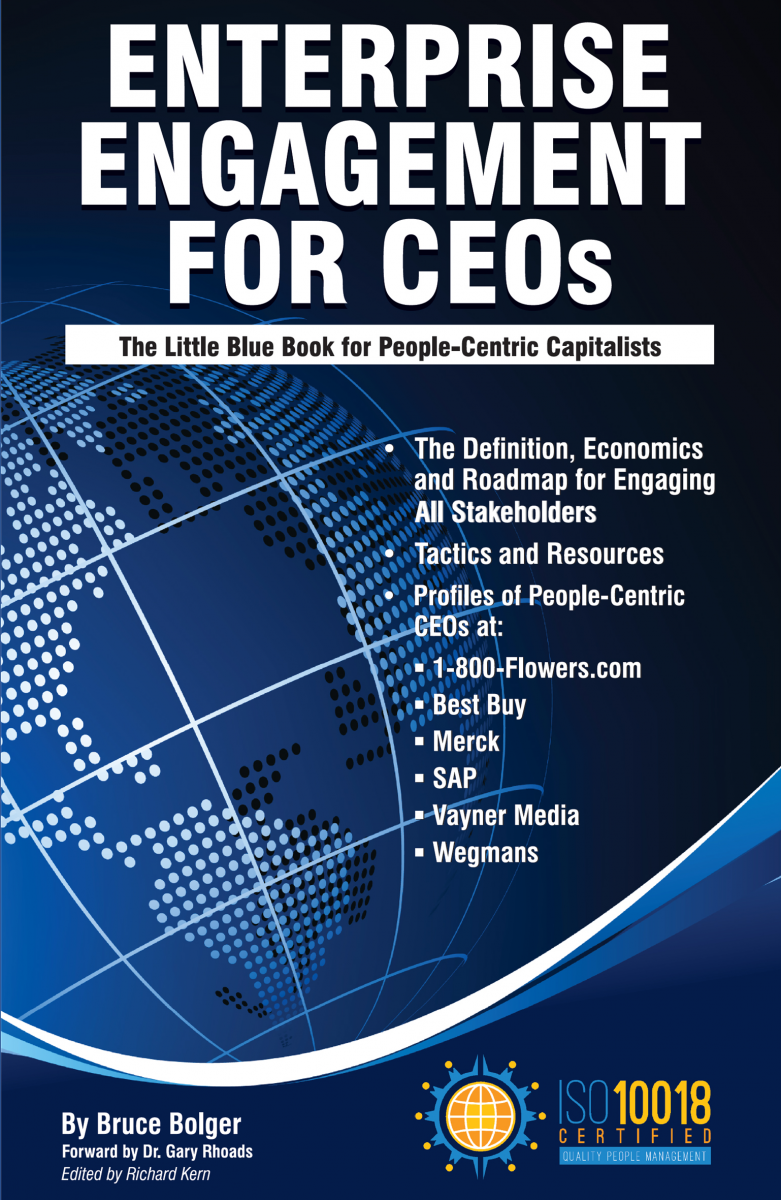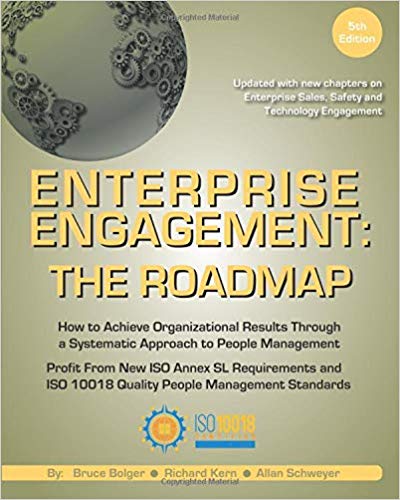With more organizations of all sizes publishing Corporate Sustainability (or Responsibility) reports, the Enterprise Engagement Alliance at TheEEA.org has created a simple framework to help organizations rapidly evaluate the meaningfulness of the information provided in Securities & Exchange Commission (SEC) and other human capital disclosures for investors, customers, talent, and communities based on the subjects addressed and methodologies and metrics used. The EEA is inviting anyone to provide input into the ratings framework through April 30, 2021. See the framework below. 
The
Enterprise Engagement Alliance has proposed a simple rating framework and optional ratings program for organizations of all sizes that seek to publish meaningful human capital information for their Corporate Sustainability Reports and/or disclosures to the Securities & Exchange Commission, European, or other regulatory bodies. Scroll down or
click here to see the framework. Comments are welcome until April 30, 2021.
Using the framework of already existing ISO 30414 Human Capital Management and ISO 10018 People Engagement standards, and whichever verifiable or auditable metrics an organization selects to use for reporting purposes, the EEA Human Capital Reporting certification seeks to promote consistency in organization, presentation, content, and accountability in Human Capital Reporting and reduce the amount of work for organizations involved with responding to requests from multiple stakeholders for human capital information.
Explains Bruce Bolger, Founder of the Enterprise Engagement Alliance, “This ratings system for human capital reporting contained in Corporate Sustainability Reports or SEC filings is not to be confused with the growing and exciting movement toward a consensus on sustainability metrics. It is designed to benefit all stakeholders by providing a concise table of contents for the information provided in sustainability reporting."
This effort focuses specifically on helping organizations provide concise and meaningful reporting in a way that stakeholders can rapidly digest. The goal is to get to a point that organizations need publish only one report on their ESG practices that meets standards acceptable to most and that covers the critical topics in a meaningful way. When and if the world agrees on accounting and reporting standards on human capital, including all stakeholders, organizations will still need to produce meaningful reports outlining their people practices, says Bolger.
Focusing on Necessary Topics, Methodologies, and Metrics
Using the proposed framework, human capital reports are evaluated based on the methodologies and metrics used to manage human capital, including employees, customers, supply chains, and communities; the critical human capital issues covered in their reports, metrics used, and who is accountable for the process.
See the framework below. Reports are evaluated based on the human capital topics addressed in the reports; specificity of strategies and methodologies disclosed, the metrics used to measure them, and who is accountable. Organizations with qualifying reports will receive a logo they can use on their reports and will be featured in a searchable database on a web site of
TheEEA.org. (Those whose reports fail to achieve certification will not be published until the organization has addressed the gaps and wishes to receive a formal certification.) For a small fee, organizations can submit their Corporate Responsibility Reports to the EEA for review and certification, if the reports are qualified.
The framework below is free for all to use. The Enterprise Engagement Alliance will highlight Corporate Responsibility Reporting of public companies that meets 80% of the key criteria in a project to be developed that will engage college students interested in business or investment management supervised by EEA advisory board members.
Topics covered in the evaluation include:
1. Leadership
2. Compliance
3. Costs
4. Diversity Inclusion
5. Occupational Health and Safety
6. Organizational Culture
7. Productivity
8. Recruitment, Mobility and Turnover
9. Employee Bench Strength
10. Skills and Capabilities
11. Workforce Availability
12. Customer Engagement
13. Supply Chain Engagement
14. Community Engagement
The EEA does not seek to favor specific reporting metrics. To qualify for a positive rating, organizations can use the metrics of their choice, provided they are material to their business, verifiable and comparable from year to year. The EEA certification does not verify the validity of the information reported, but rather the topics covered. Organizations interested in seeking to verify their claims can obtain an ISO 30414 or ISO 10018 certification or turn to services such as B-Lab and others that audit human capital practices.
“Our interest in this effort results from increasing inquiries from institutional investors, which is leading more companies to review their DEI (Diversity, Equity, and Inclusion) policies,” explains Eric Darrisaw, Senior Consultant of OMNIResearch Group, an investment research firm that specializes in advising investment groups and corporations on ESG, DEI metrics, Diversity financial indexes and benchmarks, and which supports ESG education for college students. “This has come at the same time as the new emphasis on Human Capital Management reporting and the Stakeholder Capitalism movement, resulting in a convergence that will put even more pressure on large companies to disclose their people practices.”
Adds Dorien Nunez, Omni Director of Research, “Our goal is to promote analytics, training and publication of more useful, consistent information about how organizations invest in diversity and people in general to increase shareholder returns.” Darrisaw and Nunez serve on the new Advisory Board of the Enterprise Engagement Alliance created to manage this ratings system and related projects to promote the implementation of formal people management strategies in business and college-level education.
Encouraging Relevant, Effective Reporting
The Human Capital Reporting certification is designed to encourage relevant human capital reporting on critical topics that provides a concise explanation of specific organizational strategies and metrics used to make it easier for all stakeholders to make sense of them. ISO standards were chosen as the framework for topics to be covered in the reports as they represent the result of years of deliberative effort involving representatives from dozens of countries and are designed to be auditable, says Bolger.
The evaluations will be conducted and overseen by the EEA Human Capital Management Advisory Board and individuals who have gone through the Enterprise Engagement Alliance training.
Explains Bolger, “As a result of pressures from investors, talent, customers, supply chain partners, and, in the case of public companies, the SEC, more organizations are publishing Corporate Sustainability Reports (sometimes called Corporate Responsibility Reports) that are almost always included on their web sites or, in an abbreviated fashion, their SEC filings. Because of a lack of standardization of content topics, these reports vary widely in use of metrics, specificity of information, organization, not to mention length. The human capital reporting provided by public companies in SEC 10-K reports varies widely, but few cover even half of the topics considered essential in ISO 30414 and ISO 10018 standards.”
Another Human Capital Advisory Board member, Amy Armitage, Chair of Human Capital Investment & Reporting Council, explains that the goal is to “create a template that organizations can use to provide a meaningful, organized report on their human capital management practices and metrics in their Corporate Sustainability or Human Capital Reports. It provides a credible framework that organizations can use to enhance their human capital reporting to benefit stakeholders and key decision makers. If this ratings process helps simplify the process for organizations to make such disclosures, that’s an added benefit.”
The Proposed Quality in Human Capital Reporting Framework
Below is an outline of the human capital topics ISO standards consider essential in human capital reporting related to all stakeholders. Please submit any comments or recommendations to Bruce Bolger at
Bolger@TheICEE.org by Friday, April 30, 2021.
Designed to promote best practices in human capital reporting, the ratings program is largely based on ISO 30414, the first international standard for human capital reporting produced by the International Organization for Standardization, and ISO 10018 People Engagement standards, which address the need to address the interests of all stakeholders. The Quality in Human Capital Reporting ratings focuses on the quality of the disclosure information itself in terms of specificity of methodology and metrics used and is not to be confused with an ISO 30414 or ISO 10018 certification, which go a significant step further to verify through an audit process the validity of methodology and metrics information provided in human capital reporting.
Each Corporate Sustainability or Human Capital Report will be rated based on:
• The clarity of organizational purpose and definition of stakeholders.
• The specificity and comparability of metrics reporting; i.e. ISO, GRI, SASB, UN, IFRS Foundation, etc. or an internal process that can be succinctly explained and is auditable. (The EEA ratings do not dictate the use of reporting framework over another.)
• The explanation of tactical methodology to encourage stakeholder engagement outlined below consistent with the categories of the ISO 30414 Human Capital reporting and ISO 10018 People Engagement standard which include, customer, supply chain, and community engagement, as well as employees.
• Accountability—who oversees the process and how are processes baked into the culture?
Here are the human capital topics and process for evaluating the specificity of methodology and metrics provided based on the key topics in ISO standards.
1. Leadership
Methodology
• What is the organization’s defined purpose and how does it address the needs of all stakeholders?
• Who is accountable and how the organization identifies and develops leadership consistent with its purposes and the interests of all stakeholders?
• How does the organization identify and nurture its leadership in terms of processes and effectiveness, and who is accountable and how?
Potential measures
• Leadership trust.
• Span of control.
• Percentage of leaders/talents who have formal mentors or coaches.
• Percentage of leaders who have the formal function of mentors or coaches.
2. Compliance
Methodology
How does the organization utilize the compliance process to address the underlying causes of disputes?
Potential measures
• Number and type of grievance filed.
• Training hours on compliance and ethics.
• External dispute resolutions.
• Number, type and source of external audit.
• Findings and actions arising from these.
3. Costs
Methodology
How does the organization use this type of information to improve results and experiences?
Potential measures
• Total workforce costs.
• External workforce costs.
• Ratio of the basic salary and remuneration for each workforce category.
• Total costs of employment.
• Cost per hire.
• Recruitment costs.
• Turnover costs.
4. Diversity Inclusion
Methodology
What specifically does the organization do to promote diversity, equity and inclusion?
Potential measures
• Workforce diversity with respect to age, gender, nationality, disability, job family, job level/hierarchy, qualification, diversity of leadership team.
• Level of engagement of different groups in the organization’s leadership development, learning, communications, recognition, and other efforts.
• Supplier diversity programs and contracting with minority companies.
• Strategic alliances with minority and women organizations.
5. Occupational Health and Safety
Methodology
How does the organization embed occupational health and safety practices and measures into the culture?
Potential measures
• Lost-time for injuries.
• Number of occupational accidents.
• Number of people killed during work (fatality, death or mortality rate).
• Training hours on health and safety at work vs. total amount of training hours.
• Number of employees who participated the training/total numbers of employees.
6. Organizational Culture
Methodology
How is organizational culture developed, defined, communicated, and reinforced with all stakeholders and embedded into the workplace?
Potential measures
• Engagement, satisfaction, commitment.
• Retention rate.
7. Productivity
Methodology
How does the organization assess its investment in human capital?
Potential measures
• Revenue, turnover, profit per employee
• Human Capital Return on Investment or Value Add
8. Recruitment, Mobility and Turnover
Methodology
What procedures are used to ensure the recruitment of appropriate talent, design jobs for maximum engagement and efficiency, and minimize turnover?
Potential measures
• Number of qualified candidates per position
• Quality per hire
• Average length: time to fill vacant positions; time to fill vacant critical business positions
• Transition and future workforce capabilities assessment
• Percentage of positions filled internally
• Percentage of critical business positions filled internally
• Percentage of vacant critical business positions in relation to all vacant positions
9. Employee Bench Strength
Methodology
What processes are used to foster retention and job sharing?
Potential measures
• Turnover rate.
• Involuntary turnover rate.
• Involuntary critical turnover rate.
• Voluntary turnover rate (without retirement).
• Exit/turnover reasons/leaving employment by reason.
10. Skills and Capabilities
Methodology
What processes are used to ensure training relevance and effectiveness?
Potential measures
• Total development and training costs.
• Learning and development: percentage of employees who participate in training compared to total number of employees per year; average training hours per employee; number of training participants differentiated in training categories.
• Internal mobility rate.
• Workforce competency rate.
• Succession planning.
11. Workforce Availability
Methodology
What processes are used to foster workplace engagement?
Potential measures
• Absenteeism rate.
• Full-time equivalents.
• Number of employees.
• Contingent workforce; independent contractor; temporary workforce.
• Number of full-time and part-time employees.
12. Customer Engagement
Methodology
What are the organization’s commitments to customers and through what processes are they kept?
Potential measures
• Customer retention/turnover.
• Customer willingness to recommend or actual percentage who do recommend.
• Number of customers.
• Average revenue, profits per customer.
• Number of customer law suits.
13. Supply Chain Engagement
Methodology
What processes does the organization use to engage its supply chain in its core values and mission?
Potential measures
• Percentage of supply chain partners committing to an organization’s compliance statements.
• Percentage participation in training or incentive programs related to compliance.
14. Community Engagement
Methodology
What processes does the organization use to support its communities?
Potential measures
• Donations to various community causes.
• Lawsuits from communities.
For More Information
Or to Provide Input
Bruce Bolger
Enterprise Engagement Alliance
914-591-7600, ext. 230
Bolger@TheICEE.org
Master the Principles of Stakeholder Capitalism And Implementation Through Enterprise Engagement
Education, Certifications, and Information to Activate
Stakeholder Capitalism Available Nowhere Else
A complete learning, certification, and information program and a course syllabus for educators.
Training and Certification
Enterprise Engagement Alliance Education: Certified Engagement Practitioner; Advanced Engaged Practitioner, and Certified Engagement Solution Provider learning and certification programs on how to implement Stakeholder Capitalism principles at the tactical level.

Join the EEA to begin your certification process or see our other resources below.
THE ONLY BOOKS ON STAKEHOLDER CAPITALISM IMPLEMENTATION

Enterprise Engagement: The Roadmap 5th Edition
The first and most comprehensive book on Enterprise Engagement and the new ISO 9001 and ISO 10018 quality people management standards. Includes 36 chapters detailing how to better integrate and align engagement efforts across the enterprise. (312 pages, $36.)
OTHER RESOURCES TO ACTUALIZE STAKEHOLDER CAPITALISM
Communities: The Enterprise Engagement Alliance and Advocate and the Brand Media Coalition free resource centers offering access to the latest research, news, and case studies; discounts, promotions, referrals, and commissions, when appropriate to third-party solution providers from participating coalition solution provider members.
Enterprise Engagement Resources: EEXAdvisors.com provides the only curated online marketplace to access hundreds of solution providers in all areas of human capital management and enterprise engagement throughout the world.
Online Overview:
10-minute short course: click here for a 10-minute introduction to Enterprise Engagement and ISO standards from the Coggno.com learning platform.
Services:
• The Engagement Agency at EngagementAgency.net, offering: complete support services for employers, solution providers, and technology firms seeking to profit from formal engagement practices for themselves or their clients, including Brand and Capability audits for solution providers to make sure their products and services are up to date.
• C-Suite Advisory Service—Education of boards, investors, and C-suite executives on the economics, framework, and implementation processes of Enterprise Engagement.
• Speakers Bureau—Select the right speaker on any aspect of engagement for your next event.
• Mergers and Acquisitions. The Engagement Agency’s Mergers and Acquisition group is aware of multiple companies seeking to purchase firms in the engagement field. Contact Michael Mazer in confidence if your company is potentially for sale at 303-320-3777.
Enterprise Engagement Benchmark Tools: The Enterprise Engagement Alliance offers three tools to help organizations profit from Engagement. Click here to access the tools.
• ROI of Engagement Calculator. Use this tool to determine the potential return-on-investment of an engagement strategy.
• EE Benchmark Indicator. Confidentially benchmark your organization’s Enterprise Engagement practices against organizations and best practices.
• Compare Your Company’s Level of Engagement. Quickly compare your organization’s level of engagement to those of others based on the same criteria as the EEA’s Engaged Company Stock Index.
• Gauge Your Personal Level of Engagement. This survey, donated by Horsepower, enables individuals to gauge their own personal levels of engagement.
For more information, contact Bruce Bolger at Bolger@TheEEA.org, 914-591-7600, ext. 230.

















